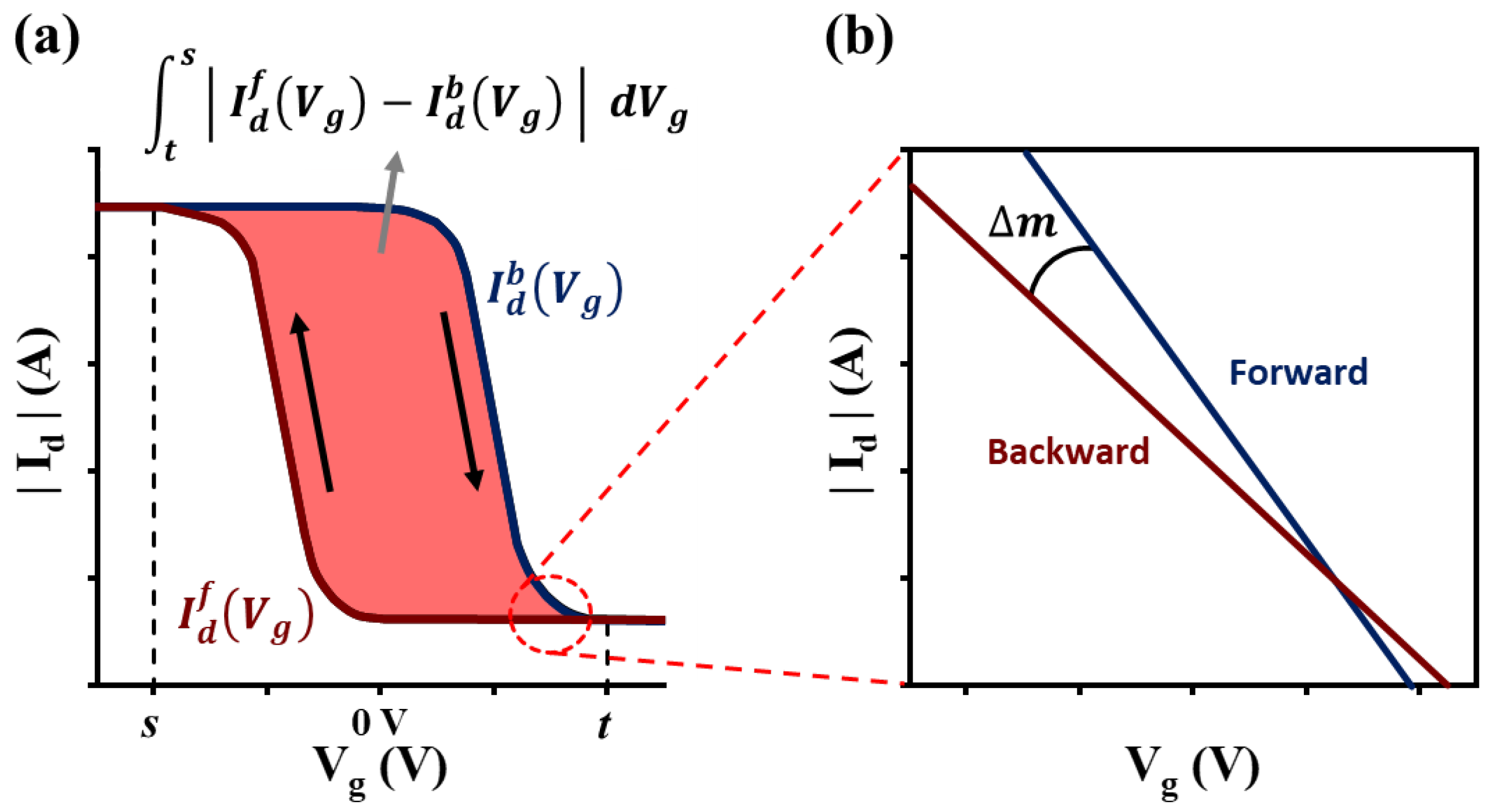Effects of Charge Traps on Hysteresis in Organic Field-Effect Transistors and Their Charge Trap Cause Analysis through Causal Inference Techniques
Abstract
1. Introduction
- (a)
- First, we perform a quantitative analysis of the hysteresis in OFETs. In particular, we generalize the current–voltage curve using one parameter that can be classified into linear and saturation regimes according to a new parameter to measure the hysteresis. We also introduce two measurement methods that quantitatively measure the degree of hysteresis in the form of a transfer curve. This enables the analysis of the causal relationship and correlation with charge traps in the future.
- (b)
- Second, we summarize the factors affecting hysteresis in OFETs. We then focus on the charge trap as one of the major causes of hysteresis and analyze the various origins of the traps in OFETs to obtain a better understanding of the effect of the traps on hysteresis. Subsequently, we develop various methods to estimate the trap density of state (DoS) using trap models generated at the semiconductor/dielectric interface. The electron and hole traps, which directly affect hysteresis, are analyzed based on this estimation, and the dynamics of the change in the threshold voltage due to these traps, which causes hysteresis over time, are also determined.
- (c)
- Lastly, we introduce various causal inference methods to quantitatively analyze the causal relationship between the traps and hysteresis as a data-based machine learning approach, which is difficult to address through only physical experiments. One effective approach involves determining the cause-and-effect relationship of each variable based on the data obtained through physical experiments. This method can be easily implemented to analyze the causal relationship between the two in the future since it can be estimated even for data that are not well observed.
2. Measuring and Quantifying Hysteresis
2.1. Transfer and Output Characteristics in OFETs
2.2. Hysteresis Parameters of Measurements
2.3. Causes of Hysteresis
- Semiconductor/dielectric interface traps (A1): Several traps occur at the semiconductor/dielectric interface in OFETs. These traps are caused by various factors such as impurities, structural defects, and self-trapping [19]. An example of a structural defect, the effective conjugation length of a polymer, can lead to some change of energy levels [19,30,31,32]. Additionally, when the rate of charge release in these traps is low enough, the sweep rate exceeds the time required to increase the thermal equilibrium, resulting in a hysteresis on the device [32].
- Charge injection from the semiconductor channel into the dielectric (A2): In OFETs, it is observed that charge can be injected from the semiconductor into the dielectric. Although this type of injection is not a charge trap, from a device perspective, it still works as a trap that produces hysteresis [19]. For example, in floating-gate transistors, the injected charge is stored in the floating metal layer semipermanently, and it affects the gate field. This may lead to a change in of the transistor, which produces hysteresis [33].
- Slow reactions of mobile charge carriers (A3) and mobile ions in semiconductors (A4): There is a decrease in the sweep speed (measuring slower), which increases the hysteresis, indicating a lower mobility, as shown in Figure 3. Furthermore, the mobile ions can be considered as the fourth reason for the hysteresis (A4) [14]. This is contrary to hysteresis generated by mobile ions in the dielectric. Mobile ions in the semiconductor move slowly toward the channel with the same polarity as the majority carrier. Reducing the number of mobile charges by changing the number of ions in the channel decreases , which causes hysteresis [34].
- Polarization of the dielectric (B1) and mobile ions in the dielectric (B2): In the case of an externally applied electric field, ferroelectric dielectrics exhibit remanent polarization, which generates an electric field along with the gate field; thus, ferroelectric dielectrics also cause hysteresis [14]. Furthermore, the mobile ions in the dielectric on the device give similar effects to those observed for the polarization of the dielectric. The hysteresis caused by this can be clearly observed for the OFET.
- Charge injection from the gate (C): Hysteresis is also caused by the charge injection between the gate electrode and the dielectric. In [19], the authors demonstrated that electrons were injected in the on state (negative ). When is reduced to 0 V, the electrons remain in the dielectric and stabilize the accumulated holes, which form the channel. A large hysteresis can be produced by electrons remaining for only a short period along with a fast sweep rate of the electrons [35]. Conversely, the rate of slower sweep decreases the hysteresis. It has been observed that floating gate transistors mainly use charge injection as the dielectric of the semiconductor [21,33].
3. Charge Traps and Analysis
3.1. Charge Traps and Their Origins
3.2. Trap DoS Analysis
- The charge density across the transistor channel from source to drain is uniform.
- The Fermi function for the trapped hole uses a zero-temperature approximation step function.
- The valence band edge with the occupancy and effective density of the extended state using the Boltzmann function is approximated as a discrete energy level.
- The dependence on temperature of the Fermi energy and interface potential was neglected (neglecting the statistical shift).
4. Hysteresis from Traps
4.1. Electron Traps
- -
- The results were dominated by a long-lifetime deep electronic support at the pentacene or interface. The negative charges initially accumulated in the channel during the off-on sweeps, and then the traps were filled. During sweeps to negative bias, hole carriers were generated more than currently required for and the gate channel capacitance. Since the net charge satisfied the charge-voltage relationship, there must be an additional hole to balance the negative charge. Conversely, with hole accumulation, the on-to-off sweep began; hence, there was no stored negative charge. Thus, additional holes generated additional during the off-on sweep for the same .
4.2. Hole Traps
4.3. Simulated Effects from Trap Charging
4.4. Dynamic Analysis of Hysteresis from the Traps
5. Discussion: Limitation and Data Causality Analysis
5.1. Limitations of Quantification of the Effects of Traps for the Hysteresis
5.2. Inferring the Causality from Data
- (i)
- Potential outcome framework: Neyman and Rubin [83,84] proposed the potential outcome framework. In this framework, there are two possible outcomes for each unit if the treatments are binary values [85]. Here, indicates the control treatment, and is for the treated one. Consequently, there exist two potential outcomes, and by and , respectively. In the experiment, we observe only one potential outcome corresponding to the assigned treatment , which is called observed outcome . Otherwise, we refer to it as the counterfactual outcome. For the individual treatment , the individual treatment effect (ITE) is defined by Thus, we can analyze the effect of treatment on the outcomes. For example, the average treatment effect (ATE) can be calculated as follows:where denotes the expectation of the random variable over an individual . Therefore, the potential outcome framework determines the existence of a causality in which the outcomes can change based on the treatment.
- (ii)
- Structural causal models framework: SCMs present an easy-to-see relationship of causality [86]. SCM is a method used to rearrange and analyze a structure using a causal graph as an equation [87]. Here, a causal graph, , is a directed graph that represents the causal relationship between variables, where denotes the node set and denotes the edge set. Causal graphs are regarded as a special class of Bayesian networks, with edges representing causal relationships that satisfy the well-defined criterion of conditional independence. To better understand this concept, we consider only the modeling association without any causal modeling [84]. Consequently, if we model the data distribution for data, we can use the chain rule of probability to factorize any distribution, as follows:
- Defining variables and data preprocessing: In this step, we first define the input variables and output variables considered in the experiment. For example, in the relationship between traps and hysteresis, trap sources can be input variables and the hysteresis index can be output variables. Next, an appropriate preprocessing step such as noise or outlier filtering is required for the values of the defined variables.
- Finding relationships by estimating joint distribution (or conditional distribution) from sampled data: After the variables are well defined, it is necessary to statistically estimate the joint distribution or conditional distribution through the data sampling process to obtain the relationship between each variable. If it is difficult to accurately find the distribution through data, it can be approximated using well-known probability distribution models.
- Inferring causal relations by causal discovery methods: Finally, based on the relationship between variables and data, an appropriate causal discovery algorithm is used to find a causal graph as shown in Figure 14, and based on this, the causality between each variable is analyzed.
5.3. Causal Structure Discovery
6. Conclusions
Author Contributions
Funding
Conflicts of Interest
References
- Chen, F. Organic semiconductors. Encycl. Mod. Opt. 2018, 5, 220–231. [Google Scholar]
- Kunkel, C.; Margraf, J.T.; Chen, K.; Oberhofer, H.; Reuter, K. Active discovery of organic semiconductors. Nat. Commun. 2021, 12, 2422. [Google Scholar] [CrossRef] [PubMed]
- Zhang, Q.; Hu, W.; Sirringhaus, H.; Müllen, K. Recent progress in emerging organic semiconductors. Adv. Mater. 2022, 34, e2108701. [Google Scholar] [CrossRef] [PubMed]
- Lamport, Z.A.; Haneef, H.F.; Anand, S.; Waldrip, M.; Jurchescu, O.D. Tutorial: Organic field-effect transistors: Materials, structure and operation. J. Appl. Phys. 2018, 8, 071101. [Google Scholar] [CrossRef]
- Małachowski, M.; Żmija, J. Organic field-effect transistors. Opto Electron. Rev. 2010, 18, 121–136. [Google Scholar] [CrossRef]
- Horowitz, G. Organic field-effect transistors. Adv. Mater. 1999, 10, 365–377. [Google Scholar] [CrossRef]
- Klauk, H. Organic thin-film transistors. Chem. Soc. Rev. 2010, 39, 2643–2666. [Google Scholar] [CrossRef]
- Sirringhaus, H. Organic field-effect transistors: The path beyond amorphous silicon. Adv. Mater. 2014, 26, 1319–1335. [Google Scholar] [CrossRef]
- Wang, C.; Dong, H.; Hu, W.; Liu, Y.; Zhu, D. Semiconducting π-conjugated systems in field-effect transistors: A material odyssey of organic electronics. Chem. Rev. 2012, 112, 2208–2267. [Google Scholar] [CrossRef]
- Klauk, H. Organic Electronics, Materials, Manufacturing and Applications; Wiley-VCH: Weinheim, Germany, 2006. [Google Scholar]
- Glowacki, I.; Jung, J.; Salyga, G.W.; Chapran, M.; Luczak, A.; Dupont, B.G.R.; Luszczynska, B.; Ulanski, J. Role of charge–carrier trapping in organic optoelectronic devices. Disp. Imaging 2017, 2, 279–319. [Google Scholar]
- Raveendran, R.; Namboothiry, M.A.G. Bias stress stability and hysteresis in elastomeric dielectric based solution processed OFETs. Mater. Res. Bull. 2021, 146, 111596. [Google Scholar] [CrossRef]
- Bobbert, A.; Sharma, A.; Mathijssen, S.; Kemerink, M.; de Leeuw, D. Operational stability of organic field-effect transistors. Adv. Mater. 2021, 24, 1146–1158. [Google Scholar] [CrossRef] [PubMed]
- Park, H.; Kwon, J.; Kang, B.; Kim, W.; Kim, Y.-H.; Cho, K.; Jung, S. Control of concentration of nonhydrogen-bonded hydroxyl groups in polymer dielectrics for organic field-effect transistors with operational stability. ACS Appl. Mater. 2018, 10, 24055–24063. [Google Scholar] [CrossRef] [PubMed]
- Hwang, D.K.; Fuentes-Hernandez, C.; Kim, J.; Potscavage Jr, W.J.; Kim, S.-J.; Kippelen, B. Top-Gate organic field-effect transistors with high environmental and operational stability. Adv. Mater. 2011, 23, 1293–1298. [Google Scholar] [CrossRef] [PubMed]
- Liu, C.; Xu, Y.; Noh, Y.Y. Contact engineering in organic field-effect transistors. Mater. Today 2015, 18, 79–96. [Google Scholar] [CrossRef]
- Anand, S.; Goetz, K.P.; Lamport, Z.A.; Zeidell, A.M.; Jurchescu, O.D. Field-dependent charge transport in organic thin-film transistors: Impact of device structure and organic semiconductor microstructure. Appl. Phys. Lett. 2019, 115, 073301. [Google Scholar] [CrossRef]
- Ng, T.; Chabinyc, M.; Street, R.A.; Salleo, A. Bias stress effects in organic thin film transistors. In Proceedings of the 45th Annual IEEE International Reliability Physics Symposium, Phoenix, AZ, USA, 15–19 April 2007. [Google Scholar]
- Egginger, M.; Bauer, S.; Schwdiauer, R.; Neugebauer, H.; Sariciftci, N.S. Current versus gate voltage hysteresis in organic field effect transistors. Mon. Chem. 2009, 140, 735–750. [Google Scholar] [CrossRef]
- Katz, E.H.; Hong, X.M.; Dodabalapur, A.; Sarpeshkar, R. Organic field-effect transistors with polarizable gate insulators. J. Appl. Phys. 2002, 91, 1572. [Google Scholar] [CrossRef]
- Ling, Q.D.; Liaw, D.J.; Zhu, C.; Chan, D.S.H.; Kang, E.T.; Neoh, K.G. Polymer electronic memories: Materials, devices and mechanisms. Prog. Polym. Sci. 2008, 33, 917–978. [Google Scholar] [CrossRef]
- Lang, D.V.; Chi, X.; Siegrist, T.; Sergent, A.M.; Ramirez, A.P. Biasdependent generation and quenching of defects in pentacene. Phys. Rev. Lett. 2003, 93, 076601. [Google Scholar] [CrossRef]
- Häusermanna, R.; Batlogg, B. Gate bias stress in pentacene field-effect-transistors: Charge trapping in the dielectric or semiconductor. Appl. Phys. Lett. 2011, 99, 175. [Google Scholar] [CrossRef]
- Andersson, L.M.; Ingans, O. Non-equilibrium effects on electronic transport in organic field effect transistors. Org. Electron. 2007, 8, 423–430. [Google Scholar] [CrossRef]
- Goldmanna, C.; Haas, S.; Krellner, C.; Pernstich, K.P.; Gundlach, D.J.; Batlogg, B. Hole mobility in organic single crystals measured by a flip-crystal field effect technique. J. Appl. Phys. 2004, 96, 2080–2086. [Google Scholar] [CrossRef]
- Kus, M.; Alic, T.Y.; Kirbiyik, C.; Baslak, C.; Kara, K.; Kara, D.A. Synthesis of nanoparticles. Micro Nano Technol. 2018, 1, 392–429. [Google Scholar]
- Habisreutinger, N.; Noel, N.K.; Snaith, H.J. Hysteresis index: A figure without merit for quantifying hysteresis in perovskite solar cells. ACS Energy Lett. 2018, 10, 2472–2476. [Google Scholar] [CrossRef]
- Lee, J.; Kim, S.; Bae, S.; Lee, D.; Lin, O.; Yang, Y.; Park, N. The interplay between trap density and hysteresis in planar heterojunction perovskite solar cells. Nano Lett. 2017, 17, 4270–4276. [Google Scholar] [CrossRef]
- D’Angelo, P.; Stoliar, P.; Cramer, T.; Cassinese, A.; Zerbetto, F.; Biscarini, F. Quantitative analysis of charge-carrier trapping in organic thin-film transistors from transfer characteristics. Appl. Phys. A 2009, 95, 55–60. [Google Scholar] [CrossRef]
- Schwödiauer, R.; Neugschwandtner, G.S.; Gogonea, S.B.; Bauer, S.; Wirges, W. Low-dielectric-constant cross-linking polymers: Film electrets with excellent charge. Appl. Phys. Lett. 1999, 75, 3998–4000. [Google Scholar] [CrossRef]
- Schmechel, R.; von Seggern, H. Electronic traps in organic transport layers. Phys. Org. Seniconductor 2004, 201, 1215–1235. [Google Scholar] [CrossRef]
- Haneef, H.F.; Zeidell, A.M.; Jurchescu, O.D. Charge carrier traps in organic semiconductors: A review on the underlying physics and impact on electronic devices. RSC J. Mater. Chem. C 2020, 8, 759–787. [Google Scholar] [CrossRef]
- Sze, S.M.; Ng, K.K. Physics of Semiconductor Devices; Wiley: Hoboken, NJ, USA, 2007. [Google Scholar]
- Star, A.; Gabriel, J.-C.P.; Bradley, K.; Gru, G. Electronic detection of specific protein binding using nanotube FET devices. NANO Lett. 2003, 3, 459–463. [Google Scholar] [CrossRef]
- Cayadi, T.; Tan, H.S.; Mhaisalkar, S.G.; Lee, P.S.; Boey, F.Y.C.; Chen, Z.K.; Ng, C.M.; Rao, V.R.; Qi, G.J. Electret mechanism, hysteresis, and ambient performance of sol-gel silica gate dielectrics in pentacene field-effect transistors. Appl. Phys. Lett. 2007, 91, 242107. [Google Scholar] [CrossRef]
- Völkel, A.R.; Street, R.A.; Knipp, D. Carrier transport and density of state distributions in pentacene transistors. Phys. Rev. B Condens. Matter Mater. Phys. 2002, 66, 195336. [Google Scholar] [CrossRef]
- Bässler, H. Charge transport in disordered organic photoconductors a Monte Carlo simulation study. Phys. Status Solidi 1993, 175, 15–56. [Google Scholar] [CrossRef]
- Horowitz, G. Validity of the concept of band edge in organic semiconductors. J. Appl. Phys. 2015, 118, 115502. [Google Scholar] [CrossRef]
- Arkhipov, I.V.; Heremans, P.; Emelianova, E.V.; Adriaenssens, G.J.; Bässler, H. Weak-field carrier hopping in disordered organic semiconductors: The effects of deep traps and partly filled density-of-states distribution. J. Phys. Condens. Matter 2002, 14, 9899–9911. [Google Scholar] [CrossRef]
- Horowitz, G.; Delannoy, P. An analytical model for organic-based thin-film transistors. J. Appl. Phys. 1991, 70, 469–475. [Google Scholar] [CrossRef]
- Horowitz, G.; Lang, P.; Mottaghi, M.; Aubin, H. Extracting parameters from the current–voltage characteristics of organic field-effect transistors. Adv. Funct. Mater. 2004, 14, 1069–1074. [Google Scholar] [CrossRef]
- Vissenberg, M.C.J.M.; Matters, M. Theory of the field-effect mobility in amorphous organic transistors. Phys. Rev. B Condens. Matter Mater. Phys. 1998, 57, 12964–12967. [Google Scholar] [CrossRef]
- Coropceanu, V.; Cornil, J.; da Silva Filho, D.A.; Olivier, Y.; Silbey, R.; Brédas, J.-L. Charge transport in organic semiconductors. Chem. Rev. 2007, 107, 926–952. [Google Scholar] [CrossRef]
- Baranovskii, S.D. Theoretical description of charge transport in disordered organic semiconductors. Phys. Status Solidi B 2014, 251, 487–525. [Google Scholar] [CrossRef]
- Rivnay, J.; Noriega, R.; Northrup, J.E.; Kline, R.J.; Toney, M.F.; Salleo, A. Structural origin of gap states in semicrystalline polymers and the implications for charge transport. Phys. Rev. B Condens. Matter Mater. Phys. 2011, 83, 121306. [Google Scholar] [CrossRef]
- Fratini, S.; Mayou, D.; Ciuchi, S. The transient localization scenario for charge transport in crystalline organic materials. Adv. Funct. Mater. 2016, 26, 2292–2315. [Google Scholar] [CrossRef]
- Kotadiya, N.B.; Mondal, A.; Blom, P.W.M.; Andrienko, D.; Wetzelaer, G.A.H. A window to trap-free charge transport in organic semiconducting thin films. Nat. Mater. 2019, 18, 1182–1186. [Google Scholar] [CrossRef] [PubMed]
- Zuo, G.; Linares, M.; Upreti, T.; Kemerink, M. General rule for the energy of water-induced traps in organic semiconductors. Nat. Mater. 2019, 18, 588–593. [Google Scholar]
- Sirringhaus, H. Device physics of solution-processed organic field-effect transistors. Adv. Mater. 2005, 17, 2411–2425. [Google Scholar] [CrossRef]
- Dasari, R.R.; Wang, X.; Wiscons, R.A.; Haneef, H.F.; Ashokan, A.; Zhang, Y.; Fonari, M.S.; Barlow, S.; Coropceanu, V.; Timofeeva, T.V.; et al. Charge-transport properties of F6TNAP-based charge-transfer cocrystals. Adv. Funct. Mater. 2019, 29, 1904858. [Google Scholar] [CrossRef]
- Chua, L.; Zaumseil, J.; Chang, J.; Ou, E.C.-W.; Ho, P.K.-H.; Sirringhaus, H.; Friend, R.H. General observation of n-type field-effect behaviour in organic semiconductors. Nature 2005, 434, 194–199. [Google Scholar] [CrossRef]
- Merlo, J.A.; Frisbie, C.D. Field effect transport and trapping in regioregular polythiophene nanofibers. J. Phys. Chem. B 2004, 108, 19169–19179. [Google Scholar] [CrossRef]
- Podzorov, V.; Menard, E.; Borissov, A.; Kiryukhin, V.; Rogers, J.A.; Gershenson, M.E. Intrinsic charge transport on the surface of organic semiconductors. Phys. Rev. Lett. 2004, 93, 086602. [Google Scholar] [CrossRef]
- Pannemann, C.; Diekmann, T.; Hilleringmann, U. Degradation of organic field-effect transistors made of pentacene. J. Mater. Res. 2004, 19, 1999–2002. [Google Scholar] [CrossRef]
- Komoda, T.; Kita, K.; Kyuno, K.; Toriumi, A. Performance and degradation in single grain-size pentacene thin-film transistors. Jpn. J. Appl. Phys. Part 1 2003, 42, 3662–3665. [Google Scholar] [CrossRef]
- Wang, Y.W.; Cheng, H.L.; Wang, Y.K.; Hu, T.H.; Ho, J.C.; Lee, C.C.; Lei, T.F.; Yeh, C.F. Influence of measuring environment on the electrical characteristics of pentacene-based thin film transistors. Thin Solid Film. 2004, 467, 215–219. [Google Scholar] [CrossRef]
- Zhu, Z.-T.; Mason, J.T.; Dieckmann, R.; Malliaras, G.G. Humidity sensors based on pentacene thin-film transistors. Appl. Phys. Lett. 2002, 81, 4643–4645. [Google Scholar] [CrossRef]
- Goldmanna, C.; Krellner, C.; Pernstich, K.P.; Haas, S.; Gundlach, D.J.; Batlogg, B. Determination of the interface trap density of rubrene single-crystal field-effect transistors and comparison to the bulk trap density. J. Appl. Phys. 2006, 99, 032507. [Google Scholar] [CrossRef]
- Diemer, P.J.; Lamport, Z.A.; Mei, Y.; Ward, J.W.; Goetz, K.P.; Li, W.; Payne, M.M.; Guthold, M.; Anthony, J.E.; Jurchescu, O.D. Quantitative analysis of the density of trap states at the semiconductor-dielectric interface in organic field-effect transistors. Appl. Phys. Lett. 2015, 107, 103303. [Google Scholar] [CrossRef]
- Grünewald, M.; Thomas, P.; Würtz, D. A Simple scheme for evaluating field effect data. Phys. Status Solidi 1980, 100, 035327. [Google Scholar] [CrossRef]
- Kalb, W.L.; Meier, F.; Mattenberger, K.; Batlogg, B. Defect healing at room temperature in pentacene thin films and improved transistor performance. Phys. Rev. B 2007, 76, 184112. [Google Scholar] [CrossRef]
- Zhang, F.; Hu, Y.; Lou, Z.; Xin, X.; Zhang, M.; Hou, Y.; Teng, F. Interface studies of well-controlled polymer bilayers and field-effect transistors prepared by a mixed-solvent method. RSC Adv. 2018, 8, 11272–11279. [Google Scholar] [CrossRef]
- Rolland, A.; Richard, J.; Kleider, J.P.; Mencaraglia, D. Electrical properties of amorphous silicon transistors and MIS-devices: Comparative study of top nitride and bottom nitride configurations. J. Electrochem. Soc. 1993, 140, 3679–3683. [Google Scholar] [CrossRef]
- Kalb, W.L.; Batlogg, B. Calculating the trap density of states in organic field-effect transistors from experiment: A comparison of different methods. Phys. Rev. B 2010, 81, 035327. [Google Scholar] [CrossRef]
- Silinsh, E.A. Organic Molecular Crystals; AIP Press: New York, NY, USA, 1994. [Google Scholar]
- Arkhipov, V.I.; Emelianova, E.V.; Adriaenssens, G.J. Effective transport energy versus the energy of most probable jumps in disordered hopping systems. Phys. Rev. B 2001, 64, 125125. [Google Scholar] [CrossRef]
- Lang, D.V.; Chi, X.; Siegrist, T.; Sergent, A.M.; Ramirez, A.P. Amorphous like density of gap states in single-crystal pentacene. Phys. Rev. Lett. 2004, 93, 086802. [Google Scholar] [CrossRef]
- Horowitz, G.; Hajlaoui, R.; Delannoy, P. Temperature dependence of the field-effect mobility of sexithiophene. determination of the density of traps. J. Phys. III 1995, 5, 355–371. [Google Scholar] [CrossRef]
- Grünewald, M.; Weber, K.; Fuhs, W.; Thomas, P. Field effect studies on a Si-H films. J. Phys. 1981, 42, 523. [Google Scholar]
- Fortunato, G.; Meakin, D.B.; Migliorato, P.; Le Comber, P.G. Field-effect analysis for the determination of gap-state density and Fermi-level temperature dependence in polycrystalline silicon. Philos. Mag. B 1998, 57, 573–586. [Google Scholar] [CrossRef]
- Kalb, W.L.; Mattenberger, K.; Batlogg, B. Oxygen-related traps in pentacene thin films: Energetic position and implications for transistor performance. Phys. Rev. B 2008, 78, 035334. [Google Scholar] [CrossRef]
- Gu, G.; Kane, M.G. Reversible memory effects and acceptor states in pentacene-based organic thin-film transistors. J. Appl. Phys. 2007, 101, 014504. [Google Scholar] [CrossRef]
- Gu, G.; Kane, M.G.; Doty, J.E.; Firester, A.H. Electron traps and hysteresis in pentacene-based organic thin-film transistors. Appl. Phys. Lett. 2005, 87, 243512. [Google Scholar] [CrossRef]
- Ucurum, C.; Goebel, H.; Yildirim, F.A.; Bauhofer, W.; Krautschneider, W. Hole trap related hysteresis in pentacene field-effect transistors. J. Appl. Phys. 2008, 104, 085401. [Google Scholar] [CrossRef]
- Lindner, T.; Paasch, G. Hysteresis in organic field-effect devices: Simulated effects due to trap recharging. J. Appl. Phys. 2005, 98, 114505. [Google Scholar] [CrossRef]
- Mathijssen, S.G.J.; Cölle, M.; Gomes, H.; Smits, E.C.P.; De Boer, B.; McCulloch, I.; Bobbert, P.A.; de Leeuw, D.M. Dynamics of threshold voltage shifts in organic and amorphous silicon field-effect transistors. Adv. Mater. 2007, 19, 2785–2789. [Google Scholar] [CrossRef]
- Wehrspohn, R.B.; Deane, S.C.; French, I.D.; Powell, M.J. Effect of amorphous silicon material properties on the stability of thin film transistors: Evidence for a local defect creation model. J. Non Cryst. Solids 2000, 266–269, 459–463. [Google Scholar] [CrossRef]
- Nogueira, A.R.; Gama, J.; Ferreira, C.A. Causal discovery in machine learning: Theories and applications. Am. Inst. Math. Sci. 2021, 8, 203–231. [Google Scholar] [CrossRef]
- Gelman, A. Causality and statistical learning. Am. J. Sociol. 2011, 117, 955–966. [Google Scholar] [CrossRef]
- Glymour, C.; Zhang, K.; Spirtes, P. Review of causal discovery methods based on graphical models. Front. Genet. 2019, 10, 524. [Google Scholar] [CrossRef]
- Guo, R.; Cheng, L.; Li, J.; Hahn, P.; Liu, H. A survey of learning causality with data: Problems and methods. ACM Comput. Surv. 2020, 53, 37. [Google Scholar] [CrossRef]
- Moraah, R.; Karami, M.; Guo, R.; Raglin, A.; Liu, H. Causal interpretability for machine learning-problems, methods and evaluation SIGKDD Explor. Newsl. 2020, 22, 18–33. [Google Scholar]
- Neal, B. Introduction to Causal Inference from a Machine Learning Perspective; Course Lecture Notes. Available online: https://bradyneal.com/causal-inference-course (accessed on 19 January 2023).
- Rubin, D.B. Estimating causal effects of treatments in randomized and nonrandomized studies. J. Educ. Psychol. 1974, 66, 688. [Google Scholar] [CrossRef]
- Xu, G.; Duong, T.D.; Li, Q.; Liu, S.; Wang, X. Causality learning: A new perspective for interpretable machine learning. arXiv 2020, arXiv:2006.16789. [Google Scholar]
- Pearl, J. Causal inference in statistics: An overview. Stat. Surv. 2009, 3, 96–146. [Google Scholar] [CrossRef]
- Shen, X.; Ma, S.; Vemuri, P.; Simon, G. Challenges and opportunities with causal discovery algorithms: Application to Alzheimer’s pathophysiology. Sci. Rep. 2020, 10, 2975. [Google Scholar] [CrossRef] [PubMed]
- DoWhy: A Python Package for Causal Inference. Available online: https://github.com/microsoft/dowhy (accessed on 19 January 2023).
- Dehejia, R.H.; Wahba, S. Propensity score-matching methods for nonexperimental causal studies. Rev. Econ. Stat. 2002, 84, 151–161. [Google Scholar] [CrossRef]
- Frangakis, C.E.; Rubin, D.B. Principal stratification in causal inference. Biometrics 2002, 58, 21–29. [Google Scholar] [CrossRef] [PubMed]
- Microsoft Research. EconML: A Python Package for ML-Based Heterogeneous Treatment Effects Estimation. 2019. Available online: https://github.com/microsoft/EconML (accessed on 19 January 2023).
- Chernozhukov, V.; Chetverikov, D.; Demirer, M.; Duflo, E.; Hansen, C.; Newey, W.; Robins, J. Double/debiased machine learning for treatment and causal parameters. arXiv 2016, arXiv:1608.00060. [Google Scholar]
- Kunzel, S.R.; Sekhon, J.S.; Bickel, P.J.; Yu, B. Metalearners for estimating heterogeneous treatment effects using machine learning. Proc. Natl. Acad. Sci. USA 2019, 116, 4156–4165. [Google Scholar] [CrossRef]
- Oprescu, M.; Syrgkanis, V.; Wu, Z.S. Orthogonal random forest for causal inference. arXiv 2018, arXiv:1806.03467. [Google Scholar]
- Foster, D.J.; Syrgkanis, V. Orthogonal statistical learning. arXiv 2019, arXiv:1901.09036. [Google Scholar]
- Chen, H.; Harinen, T.; Lee, J.; Yung, M.; Zhao, Z. Causalml: Python package for causal machine learning. arXiv 2020, arXiv:2002.11631. [Google Scholar]
- Zhao, Y.; Fang, X.; Levi, D.S. Uplift modeling with multiple treatments and general response types. arXiv 2017, arXiv:1705.08492. [Google Scholar]
- Radcliffe, N.J.; Surry, P.D. Real-World Uplift Modelling with Significance-Based Uplift Trees. White Paper TR-2011-1. Stoch. Solut. 2011, 1–33. [Google Scholar]
- Kalainathan, D.; Goudet, O. Causal discovery toolbox: Uncover causal relationships in Python. arXiv 2019, arXiv:1903.02278. [Google Scholar]
- Runge, J.; Nowack, P.; Kretschmer, M.; Flaxman, S.; Sejdinovic, D. Detecting and quantifying causal associations in large nonlinear time series datasets. Sci. Adv. 2019, 5, eaau4996. [Google Scholar] [CrossRef]
- Runge, J. Causal network reconstruction from time series: From theoretical assumptions to practical estimation. Chaos: An Interdisciplinary. J. Nonlinear Sci. 2018, 28, 075310. [Google Scholar]
- Runge, J. Conditional independence testing based on a nearest neighbor estimator of conditional mutual information. arXiv 2017, arXiv:1709.01447. [Google Scholar]
- Runge, J.; Petoukhov, V.; Donges, J.; Hlinka, J.; Jajcay, N.; Vejmelka, M.; Hartman, D.; Marwan, N.; Palus, M.; Kurths, J. Identifying causal gateways and mediators in complex spatio-temporal systems. Nat. Commun. 2015, 6, 8502. [Google Scholar] [CrossRef]
- Runge, J. Quantifying information transfer and mediation along causal pathways in complex systems. Phys. Rev. E 2015, 92, 062829. [Google Scholar] [CrossRef]
- Chalupka, K.; Perona, P.; Eberhardt, F. Visual causal feature learning. In Proceedings of the UAI’15: Proceedings of the Thirty-First Conference on Uncertainty in Artificial Intelligence, Arlington, VI, USA, 12–16 July 2015; pp. 181–190. [Google Scholar]
- Lopez-Paz, D.; Nishihara, R.; Chintala, S.; Schölkopf, B.; Bottou, L. Discovering causal signals in images. In Proceedings of the IEEE Conference on Computer Vision and Pattern Recognition (CVPR), Honolulu, HI, USA, 21–26 July 2017; pp. 58–66. [Google Scholar]
- Wang, Y.; Menkovski, V.; Wang, H.; Du, X.; Pechenizkiy, M. Causal discovery from incomplete data: A deep learning approach. In Proceedings of the AAAI 2020, New York, NY, USA, 7–12 February 2020. [Google Scholar]
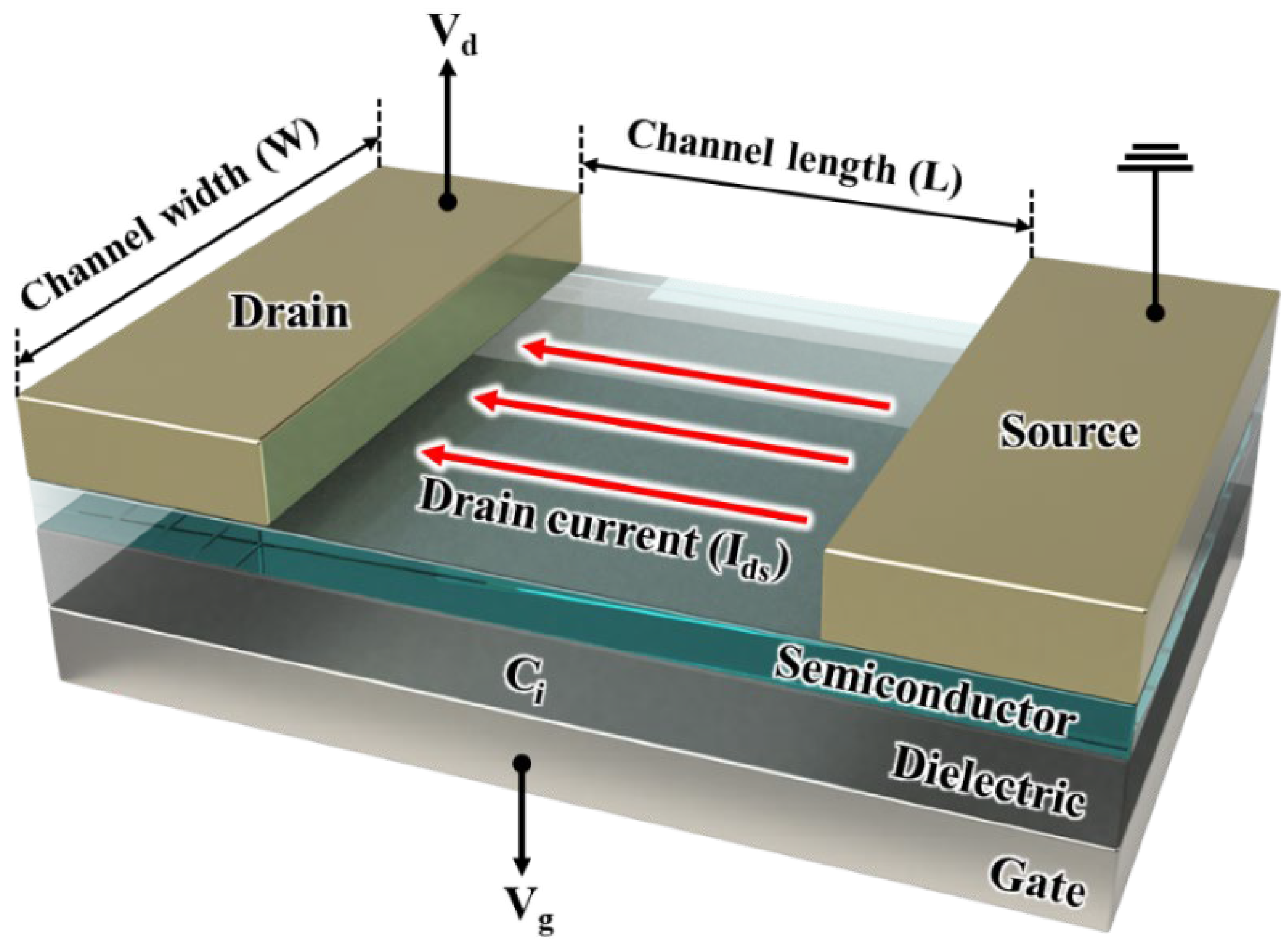
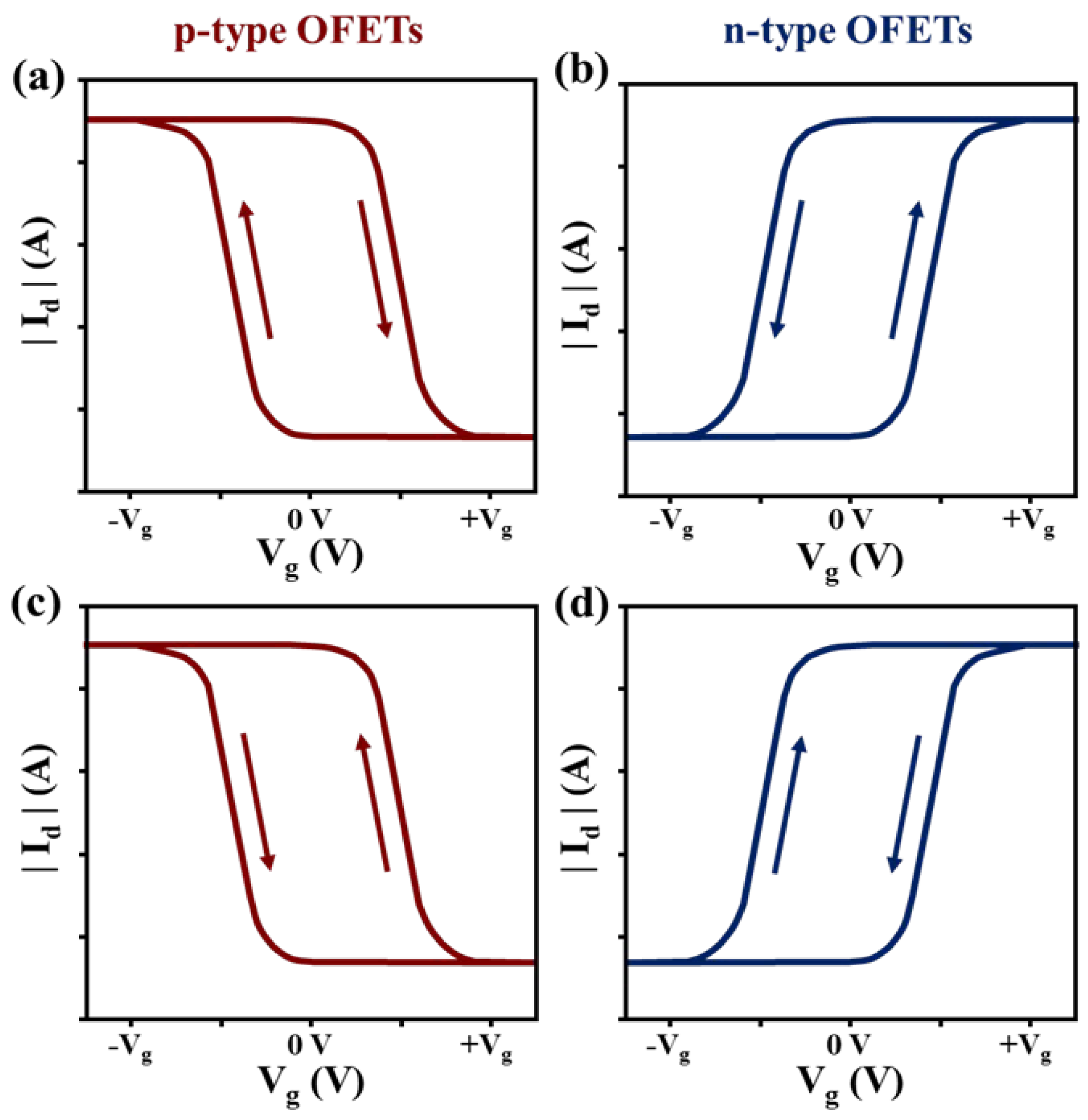
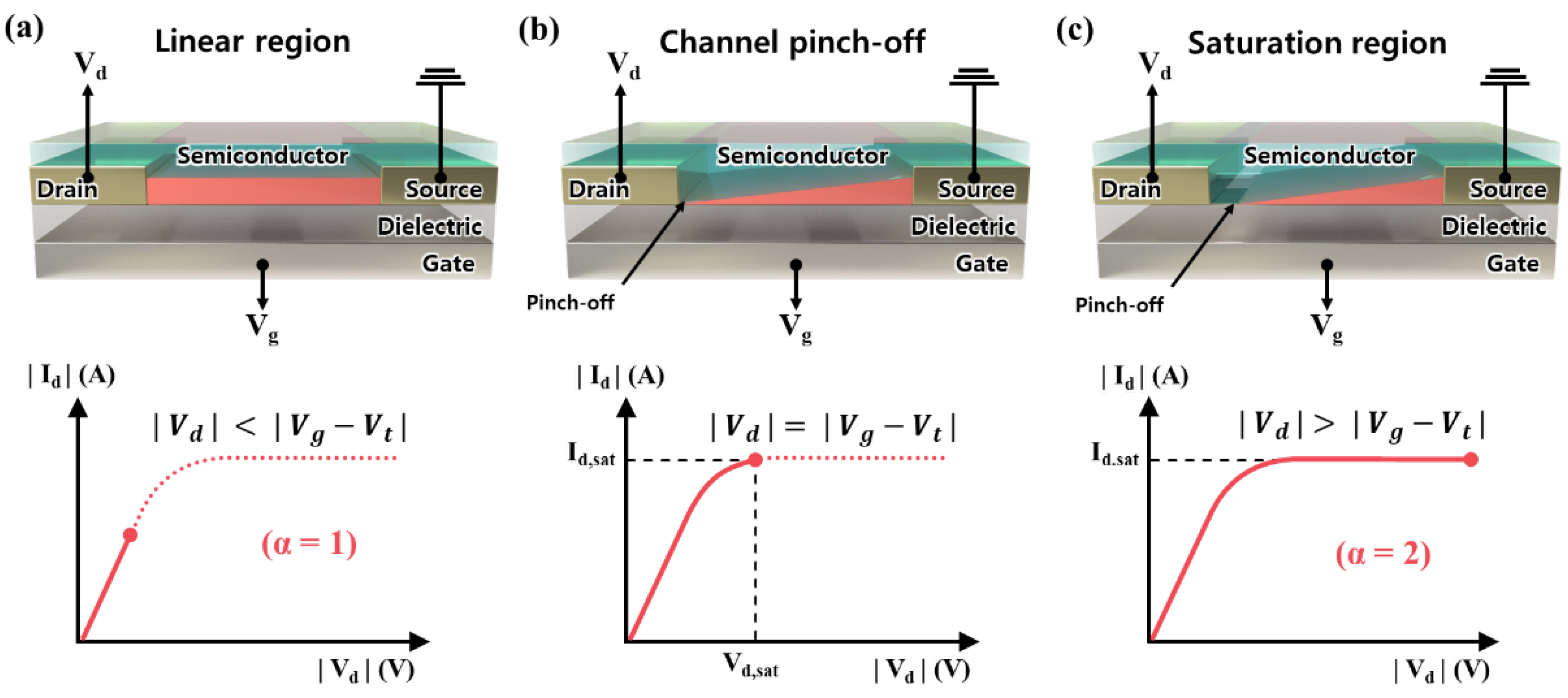
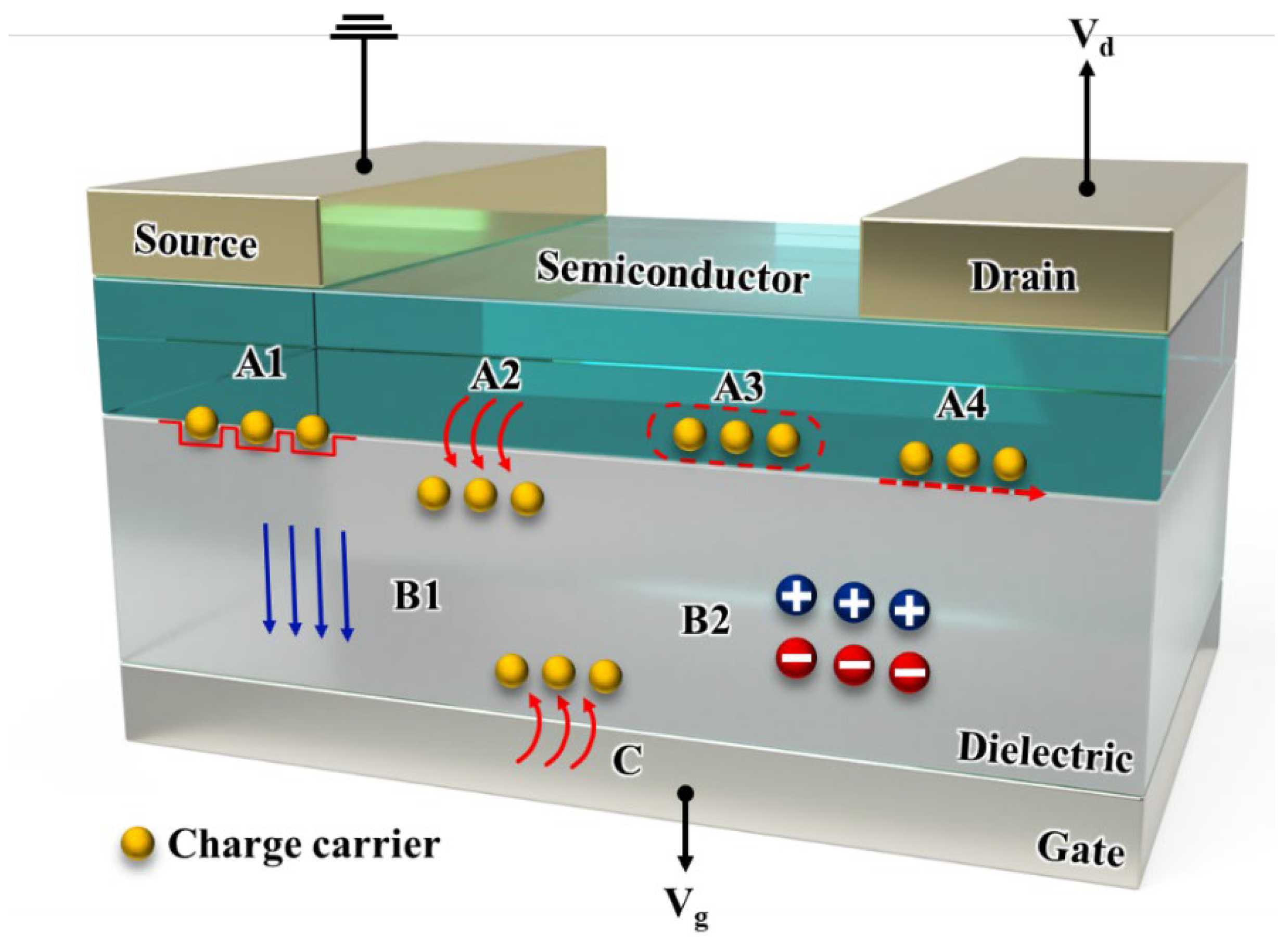
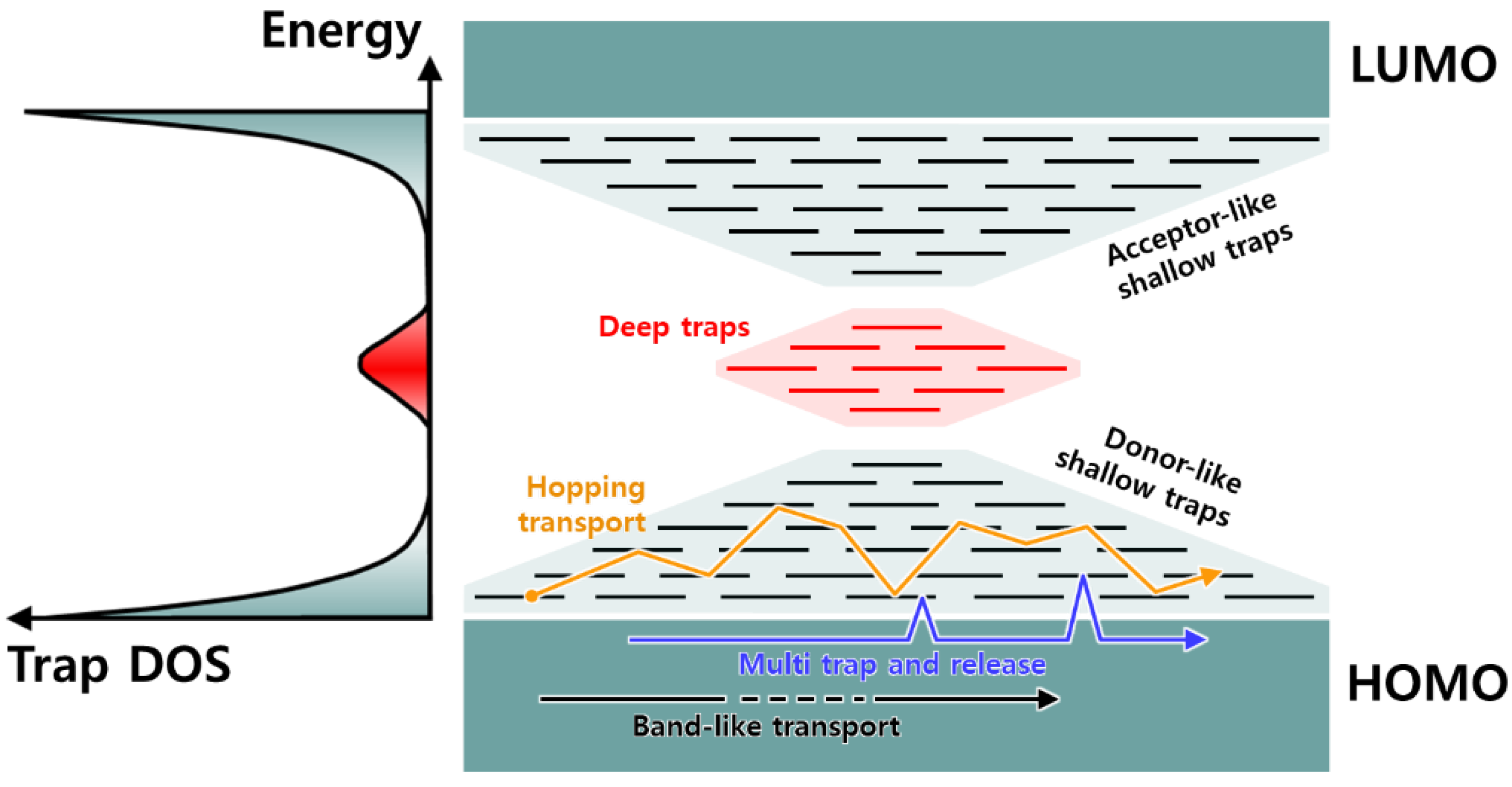
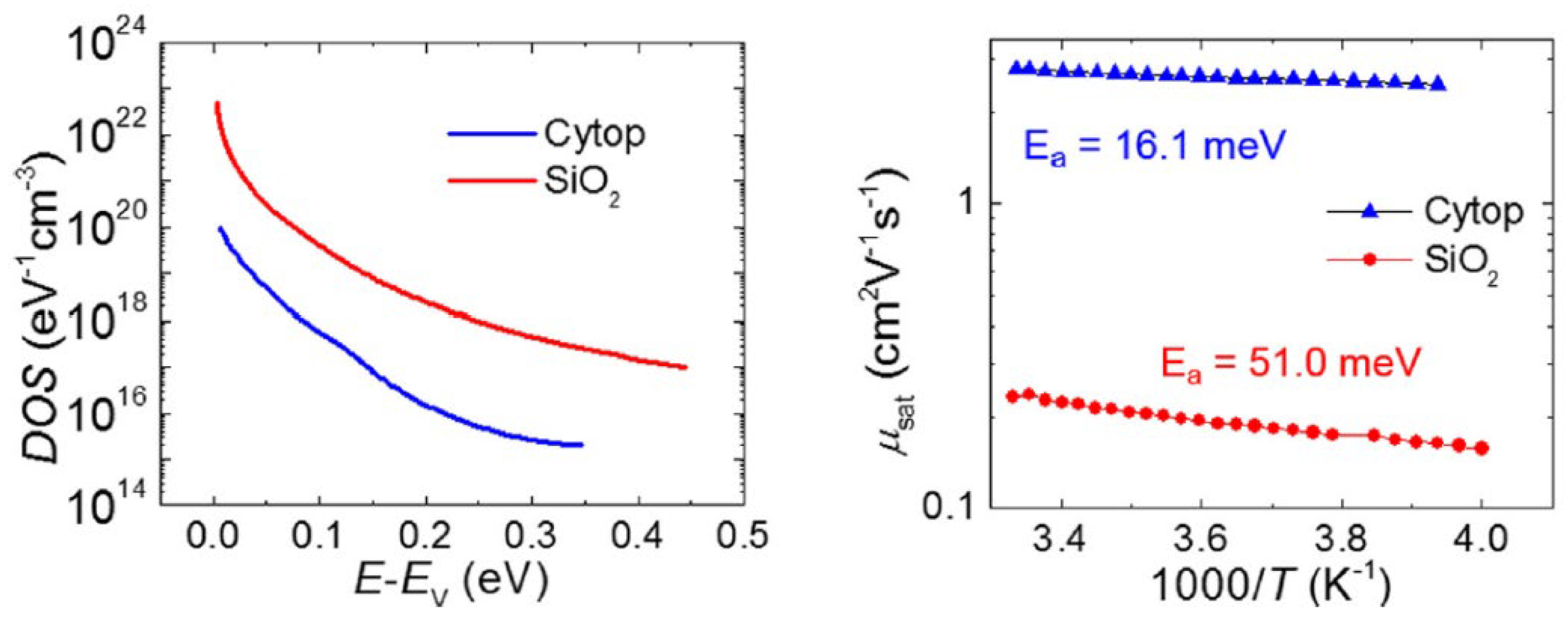
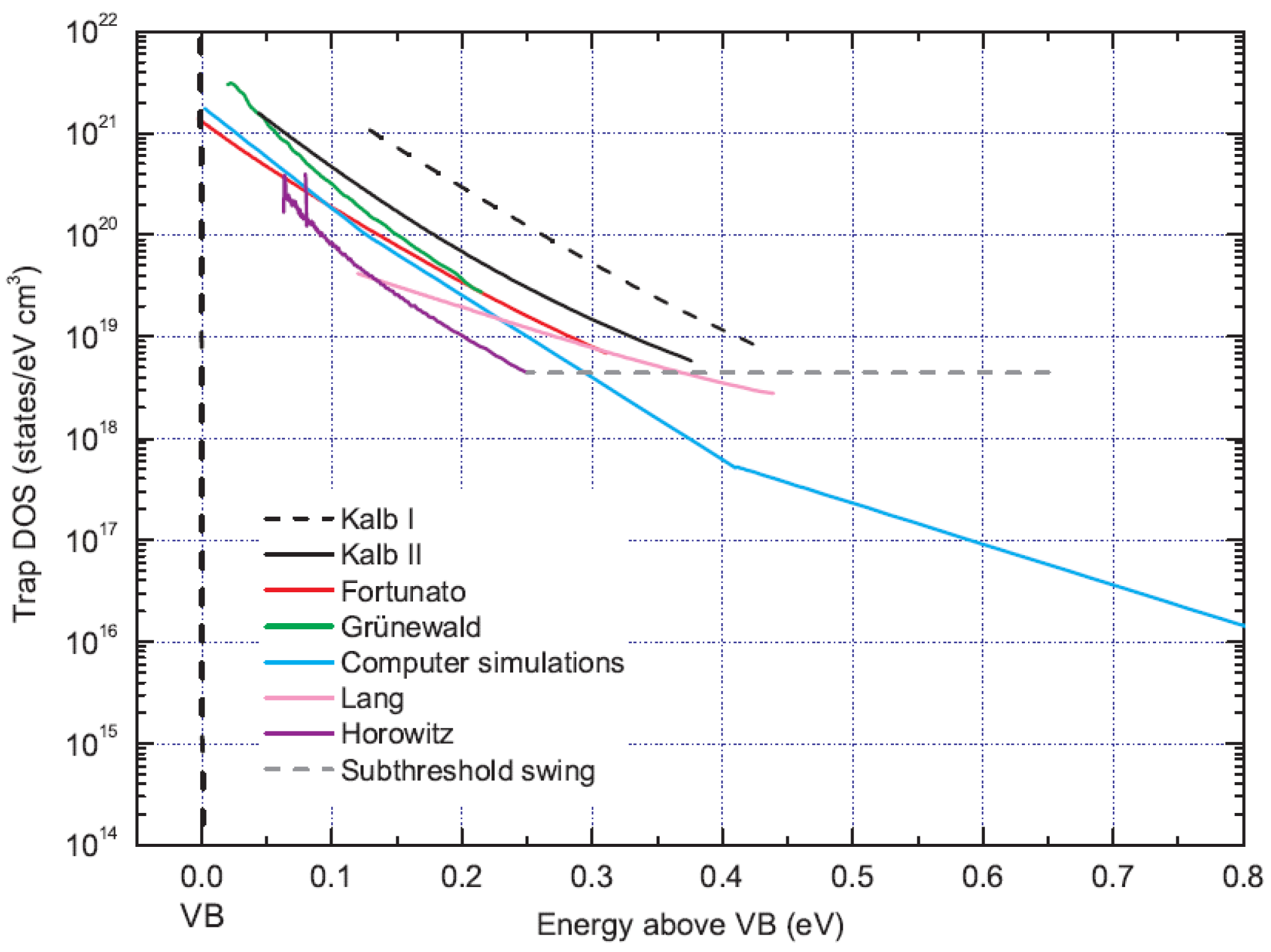
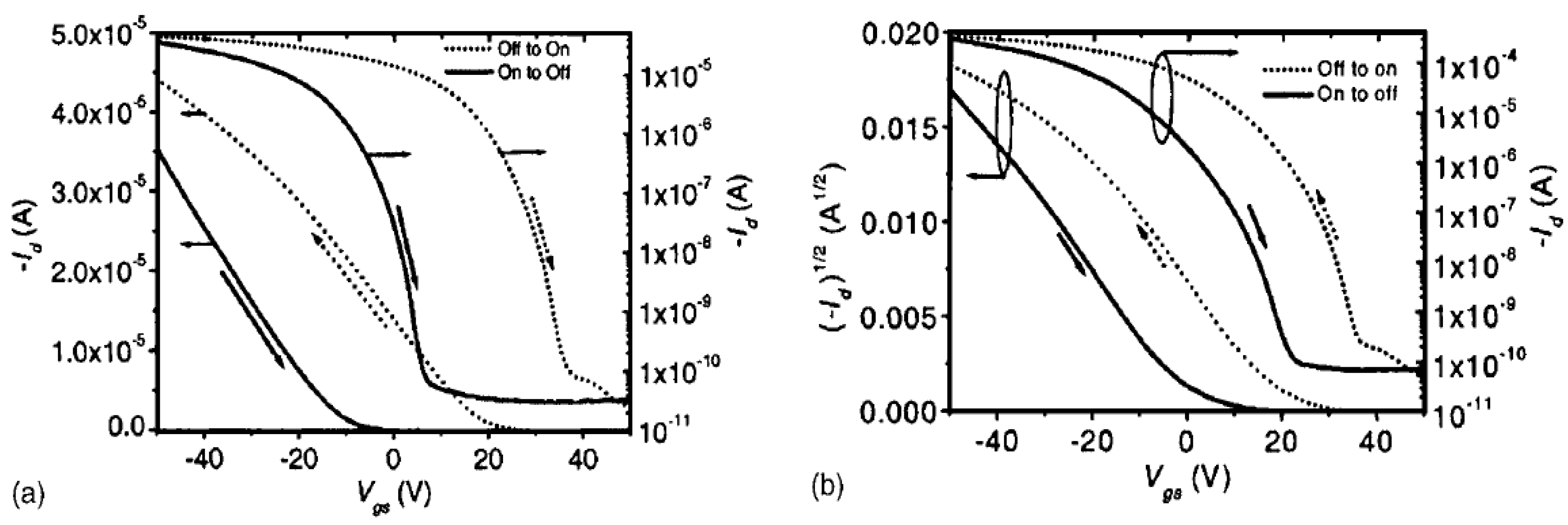

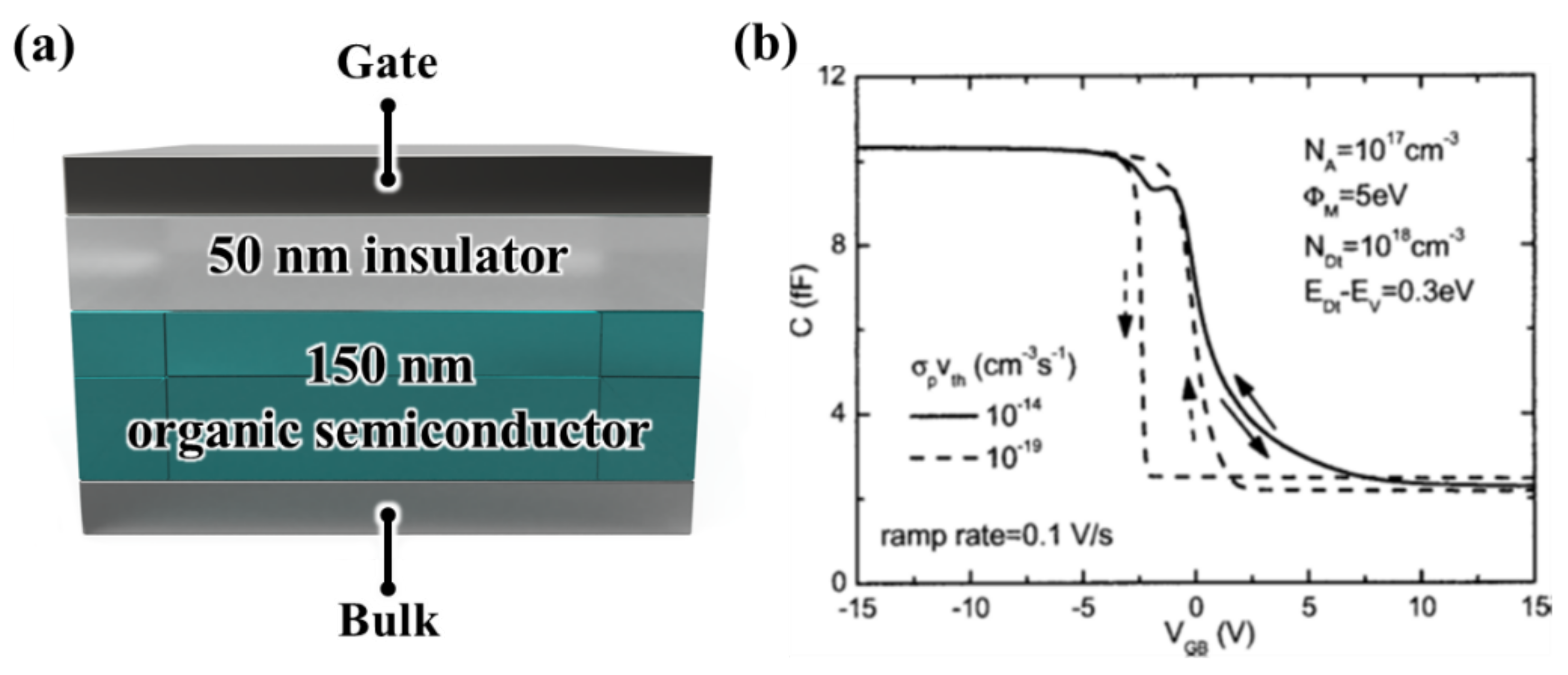
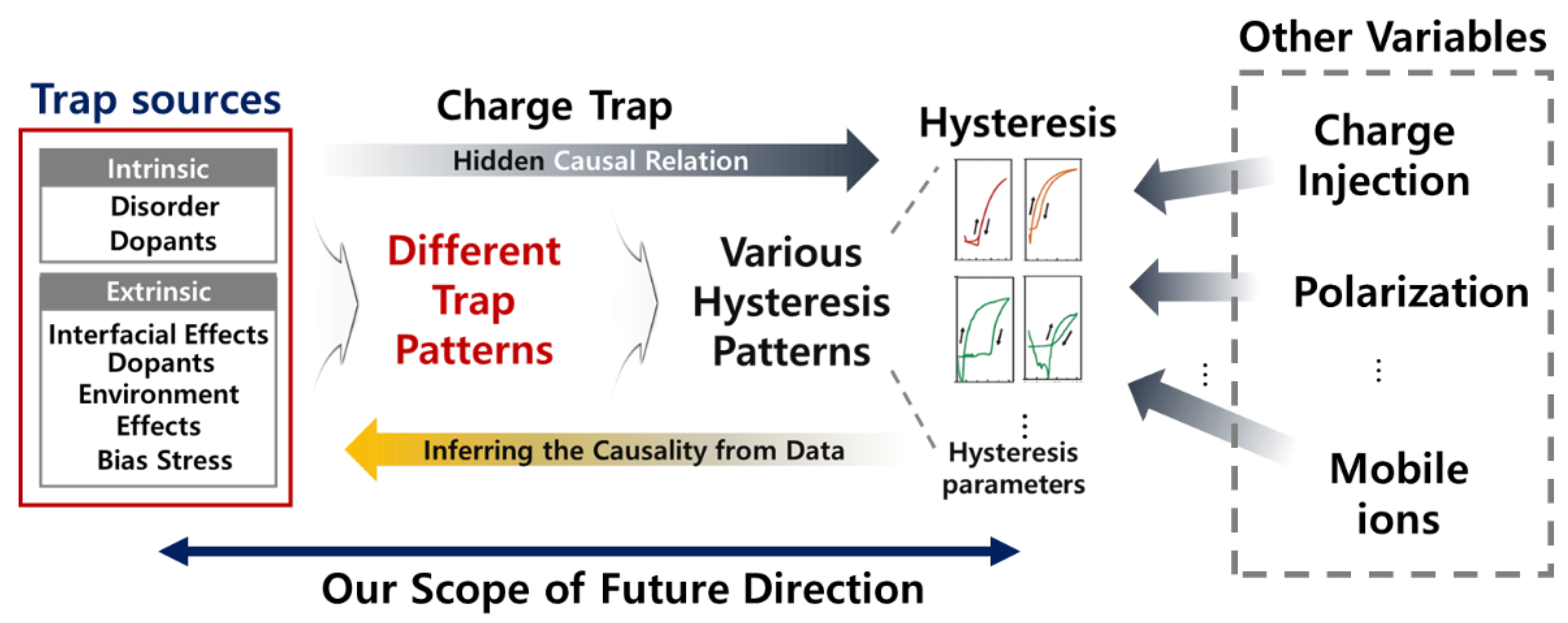

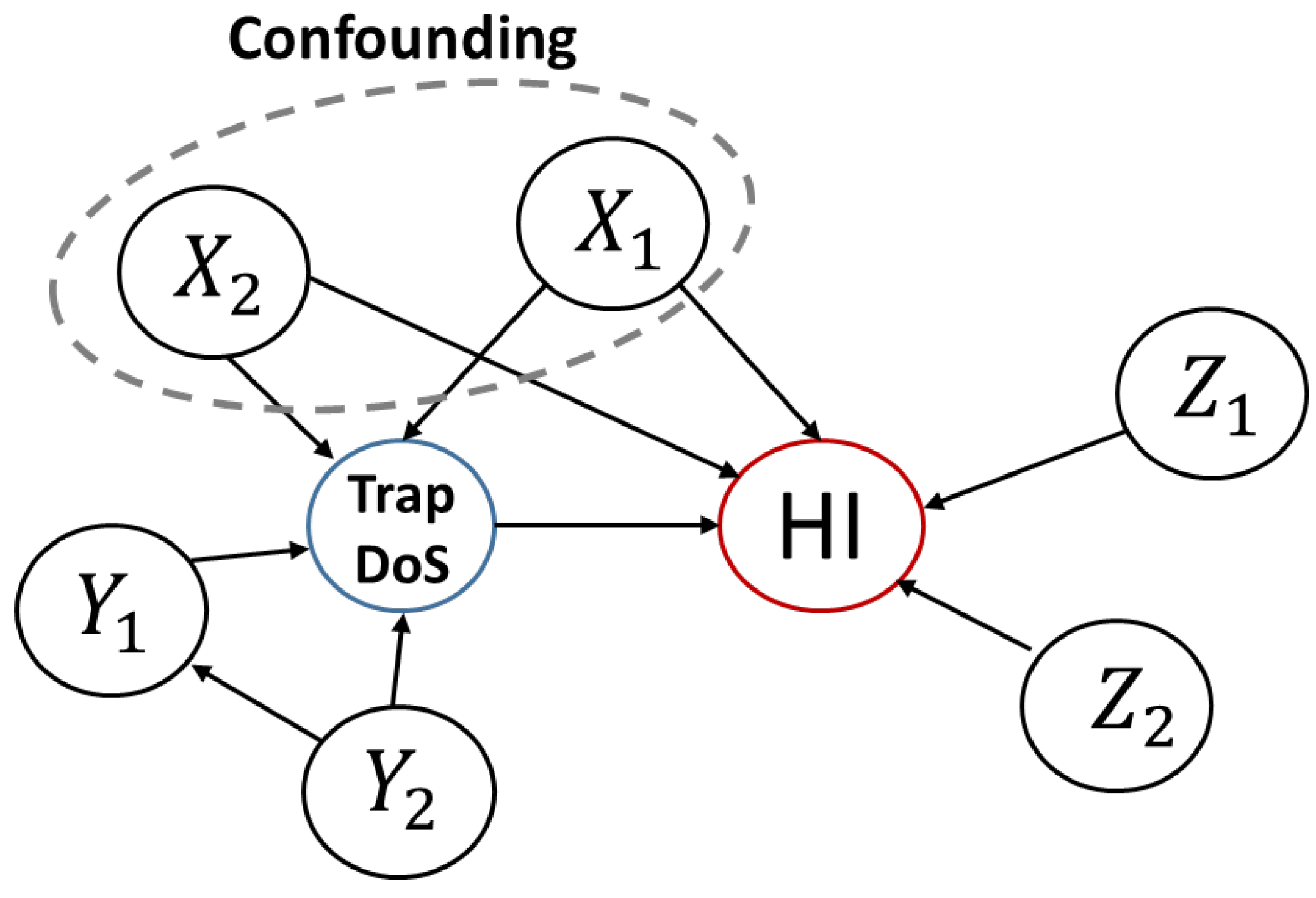
| Mechanisms | Hysteresis Sources |
|---|---|
| Effects near the semiconductor/dielectric interface | Semiconductor/dielectric interface trap, injected charge from the semiconductor into the dielectric, slow reactions of mobile charge carriers, mobile ions in the semiconductor |
| Bulk effects of the dielectric | Polarization of the dielectric, mobile ions in the dielectric |
| Charge injection from the gate | Charge injection from the gate into the dielectric |
| Intrinsic | Extrinsic | |
|---|---|---|
| Trap Sources | Disorder (Structural defects, chemical impurities, dynamic disorder) Dopants (Chemical impurities) | Dopants (Chemical impurities) Interfacial Effects (Semiconductor/dielectric interface, metal/semiconductor interface) Environment Effects (Water, oxygen, electromagnetic radiation) Bias Stress Effect (Bias stress) |
| Paper | Trap DoS Estimation | Notations |
|---|---|---|
| Lang et al. [67] | : activation energy : accumulation layer thickness interface potential volume hole density dielectric constants flatband voltage thickness of the SiO2 gate dielectric : valence band edge energy : Fermi energy | |
| Horowitz et al. [68], Grunewald et al. [69] | ||
| Fortunato et al. [70] | ||
| Kalb et al. I [71] | ||
| Kalb et al. II [64] |
| Library | Feature | Algorithms |
|---|---|---|
| DoWhy [88] | ITE estimation | Propensity score matching [89] Stratification [90] |
| EconML [91] | ITE estimation and interpreter of the causal model | Double machine learning [92] Orthogonal random forests [94,95] Meta-learners [93] Deep instrumental variables |
| Causal ML [96] | ITE estimation | Meta-learners Uplift modeling [97,98] |
| Causal Discovery Toolbox [99] | Causal structure discovery | Graph inference Pairwise inference |
| CausalNex | Learning the causal structures and estimation of effects of potential interventions from data | Bayesian networks |
| TIGRAMITE | Time series datasets for causal discovery | PCMCI [100], generally [101], CMIknn [102], mediation class [103,104] |
Disclaimer/Publisher’s Note: The statements, opinions and data contained in all publications are solely those of the individual author(s) and contributor(s) and not of MDPI and/or the editor(s). MDPI and/or the editor(s) disclaim responsibility for any injury to people or property resulting from any ideas, methods, instructions or products referred to in the content. |
© 2023 by the authors. Licensee MDPI, Basel, Switzerland. This article is an open access article distributed under the terms and conditions of the Creative Commons Attribution (CC BY) license (https://creativecommons.org/licenses/by/4.0/).
Share and Cite
Kim, S.; Yoo, H.; Choi, J. Effects of Charge Traps on Hysteresis in Organic Field-Effect Transistors and Their Charge Trap Cause Analysis through Causal Inference Techniques. Sensors 2023, 23, 2265. https://doi.org/10.3390/s23042265
Kim S, Yoo H, Choi J. Effects of Charge Traps on Hysteresis in Organic Field-Effect Transistors and Their Charge Trap Cause Analysis through Causal Inference Techniques. Sensors. 2023; 23(4):2265. https://doi.org/10.3390/s23042265
Chicago/Turabian StyleKim, Somi, Hochen Yoo, and Jaeyoung Choi. 2023. "Effects of Charge Traps on Hysteresis in Organic Field-Effect Transistors and Their Charge Trap Cause Analysis through Causal Inference Techniques" Sensors 23, no. 4: 2265. https://doi.org/10.3390/s23042265
APA StyleKim, S., Yoo, H., & Choi, J. (2023). Effects of Charge Traps on Hysteresis in Organic Field-Effect Transistors and Their Charge Trap Cause Analysis through Causal Inference Techniques. Sensors, 23(4), 2265. https://doi.org/10.3390/s23042265








